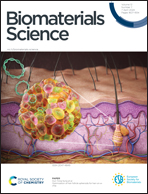Bi-functional quercetin/copper nanoparticles integrating bactericidal and anti-quorum sensing properties for preventing the formation of biofilms†
Abstract
Biofilms formed by pathogenic bacteria present a persistent risk to human health. While the eradication of matured biofilms remains a formidable challenge, delaying or preventing their formation, which is coordinately regulated by quorum sensing (QS), presents a simpler and more advantageous strategy. Quercetin, a naturally occurring compound with anti-QS properties, has the potential to act as an antibiofilm agent. However, it is plagued by certain inherent drawbacks, including poor water solubility and limited bioavailability. Furthermore, solely blocking QS is not enough to prevent biofilm formation because it lacks bactericidal properties. To address these difficulties, we fabricated bi-functional nanoparticles through the co-assembly of quercetin and copper ions in a facile manner. The resulting quercetin/copper nanoparticles (QC NPs) demonstrated minimal cytotoxicity and hemolysis in vitro. In response to the low pH of microenvironments that were populated by bacterial colonies, the QC NPs underwent disassembly to release copper ions and quercetin. The former exterminated bacteria by disrupting the integrity of the cell membrane, while the latter disrupted the processes involved in QS that are responsible for the biofilm by downregulating the expression of specific genes, effectively preventing the formation of biofilms by both Gram-negative Pseudomonas aeruginosa and Gram-positive Staphylococcus aureus. In addition, the QC NPs were integrated into a bacterial cellulose membrane. The composite membrane proved to be highly effective at inhibiting biofilm formation in vitro and demonstrated the ability to reduce inflammatory responses and accelerate the healing of bacteria-infected wounds in vivo. Overall, the bi-functional QC NPs hold great potential for use in addressing the challenges associated with the management of bacterial biofilms.



 Please wait while we load your content...
Please wait while we load your content...